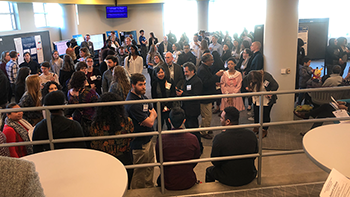Characterizing the Activity of Antimicrobial Peptides Against the Pathogenic Bacterium Clostridium difficile in an Anaerobic Environment
Description/Abstract/Artist Statement
In our lab we study oxidative stress response of Clostridioides difficile in relation to biofilm formation. Oxidative stress is the imbalance between oxidation and anti-oxidation in the bacterial system. Biofilm are extracellular matrices produced by the bacteria. C. difficile forms biofilm one of the phenotypic expression response to oxidative stress. We use peptides and metals as the major source of oxidative stress. Metals like copper and silver which are already known for their antimicrobial effect, showed stimulation of biofilm at sub-inhibitory concentrations while we notice no difference in biofilm formation when exposed to magnesium. Piscidin one of the host defense peptides (HDPs) produced by the innate immune system combats pathogens entering the host body by inducing oxidative stress. The peptide did not show significant biofilm stimulation suggesting that the response of the bacteria to different sources of oxidative stress may vary and this is worthy of more investigations.
Faculty Advisor/Mentor
Erin Purcell
Presentation Type
Poster
Disciplines
Biochemistry
Session Title
Poster Session
Location
Learning Commons, Atrium
Start Date
2-8-2020 8:00 AM
End Date
2-8-2020 12:30 PM
Characterizing the Activity of Antimicrobial Peptides Against the Pathogenic Bacterium Clostridium difficile in an Anaerobic Environment
Learning Commons, Atrium
In our lab we study oxidative stress response of Clostridioides difficile in relation to biofilm formation. Oxidative stress is the imbalance between oxidation and anti-oxidation in the bacterial system. Biofilm are extracellular matrices produced by the bacteria. C. difficile forms biofilm one of the phenotypic expression response to oxidative stress. We use peptides and metals as the major source of oxidative stress. Metals like copper and silver which are already known for their antimicrobial effect, showed stimulation of biofilm at sub-inhibitory concentrations while we notice no difference in biofilm formation when exposed to magnesium. Piscidin one of the host defense peptides (HDPs) produced by the innate immune system combats pathogens entering the host body by inducing oxidative stress. The peptide did not show significant biofilm stimulation suggesting that the response of the bacteria to different sources of oxidative stress may vary and this is worthy of more investigations.

